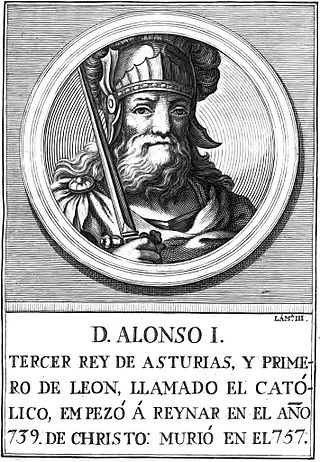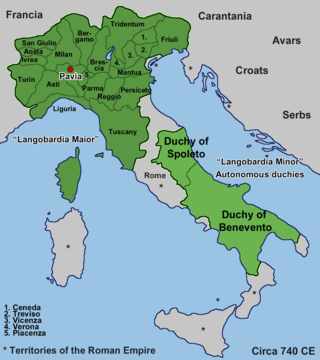Pope Gregory II was the bishop of Rome from 19 May 715 to his death. His defiance of Emperor Leo III the Isaurian as a result of the iconoclastic controversy in the Eastern Empire prepared the way for a long series of revolts, schisms, and civil wars that eventually led to the establishment of the temporal power of the popes.

Pope Gregory III was the bishop of Rome from 11 February 731 to his death. His pontificate, like that of his predecessor, was disturbed by Byzantine iconoclasm and the advance of the Lombards, in which he invoked the intervention of Charles Martel, although ultimately in vain. He was the last Pope to seek the consent of the Byzantine exarch of Ravenna for his election, and the last non-European pope until the election of Pope Francis more than 1,271 years later in 2013.

Year 740 (DCCXL) was a leap year starting on Friday of the Julian calendar, the 740th year of the Common Era (CE) and Anno Domini (AD) designations, the 740th year of the 1st millennium, the 40th year of the 8th century, and the 1st year of the 740s decade. The denomination 740 for this year has been used since the early medieval period, when the Anno Domini calendar era became the prevalent method in Europe for naming years.

The Duchy of Benevento was the southernmost Lombard duchy in the Italian Peninsula that was centred on Benevento, a city in Southern Italy. Lombard dukes ruled Benevento from 571 to 1077, when it was conquered by the Normans for four years before it was given to the Pope. Being cut off from the rest of the Lombard possessions by the papal Duchy of Rome, Benevento was practically independent from the start. Only during the reigns of Grimoald and the kings from Liutprand on was the duchy closely tied to the Kingdom of the Lombards. After the fall of the kingdom in 774, the duchy became the sole Lombard territory which continued to exist as a rump state, maintaining its de facto independence for nearly 300 years, although it was divided after 849. Benevento dwindled in size in the early 11th century, and was completely captured by the Norman Robert Guiscard in 1053.

Liutprand was the king of the Lombards from 712 to 744 and is chiefly remembered for his multiple phases of law-giving, in fifteen separate sessions from 713 to 735 inclusive, and his long reign, which brought him into a series of conflicts, mostly successful, with most of Italy. He is often regarded as the most successful Lombard monarch, notable for the Donation of Sutri in 728, which was the first accolade of sovereign territory to the Papacy.
Grimoald or Grimwald (†671) was a 7th-century King of Italy, ruling as Duke of Benevento from 647 to 662, and then as King of the Lombards from 662 until his death in 671.
Landulf IV was the prince of Capua and Benevento from 968, when he was associated with his father, Pandulf Ironhead, and prince of Salerno associated with his father from 977 or 978. In 968, his uncle Landulf III died, which lead to his rise, as Pandulf ignored the rights of Landulf II's son Pandulf II, his nephew, and instead associated his own son with the government.

Gisulf II was the third last duke of Benevento before the fall of the Lombard kingdom. He ruled from 743, when King Liutprand came down and removed Godescalc, to his death up to ten years later.

Theodo, also known as Theodo V and Theodo II, was the Duke of Bavaria from 670 or, more probably, 680 to his death. It is with Theodo that the well-sourced history of Bavaria begins. He strengthened his duchy internally and externally and, according to the medieval chronicler Arbeo of Freising, he was a prince of great power whose fame extended beyond his borders.
Transamund II was the Lombard Duke of Spoleto from 724 to 745, though he was twice driven from power by the king, Liutprand. Transamund rose to power by deposing his own father, Faroald II, and tonsuring him in a monastery.
Hilderic was the Lombard Duke of Spoleto briefly from 739 to 740. He was the first appointee of Liutprand, King of the Lombards, against the rebellious Thrasimund II.

Liutprand was the duke of Benevento from the death of his father Gisulf II in 749 until his own deposition. He reigned under the regency of his mother, Scauniperga, who supported King Aistulf, until 756.
Alboin was the Lombard Duke of Spoleto from 757 to 758. He was chosen to be duke by the Spoletan nobility without the assent of the king.

The Kingdom of the Lombards, also known as the Lombard Kingdom and later as the Kingdom of all Italy, was an early medieval state established by the Lombards, a Germanic people, on the Italian Peninsula in the latter part of the 6th century. The king was traditionally elected by the very highest-ranking aristocrats, the dukes, as several attempts to establish a hereditary dynasty failed. The kingdom was subdivided into a varying number of duchies, ruled by semi-autonomous dukes, which were in turn subdivided into gastaldates at the municipal level. The capital of the kingdom and the center of its political life was Pavia in the modern northern Italian region of Lombardy.
Faroald II was the duke of Spoleto from 703, when he succeeded his own father Thrasimund I.
Agiprand was briefly the Duke of Spoleto between 742 and 744.

The Duchy of Friuli was a Lombard duchy in present-day Friuli, the first to be established after the conquest of the Italian peninsula in 568. It was one of the largest domains in Langobardia Major and an important buffer between the Lombard kingdom and the Slavs, Avars, and the Byzantine Empire. The original chief city in the province was Roman Aquileia, but the Lombard capital of Friuli was Forum Julii, modern Cividale.
Lucerius was the third Abbot of Farfa, succeeding Aunepert in 724 at the latest. He was originally from Provence and had been raised at Farfa by Thomas of Maurienne, the first abbot. Lucerius' abbacy was a period of growth and expansion on the part of the abbey. In his first year, he received a grant of a church with its (unspecified) lands from Duke Thrasimund II of Spoleto. This church, dedicated to Saint Getulius, lay within the jurisdiction of the Diocese of Rieti, and according to the tenth-century Exceptio Relationum Thrasimund had to compensate the bishop for his loss.








